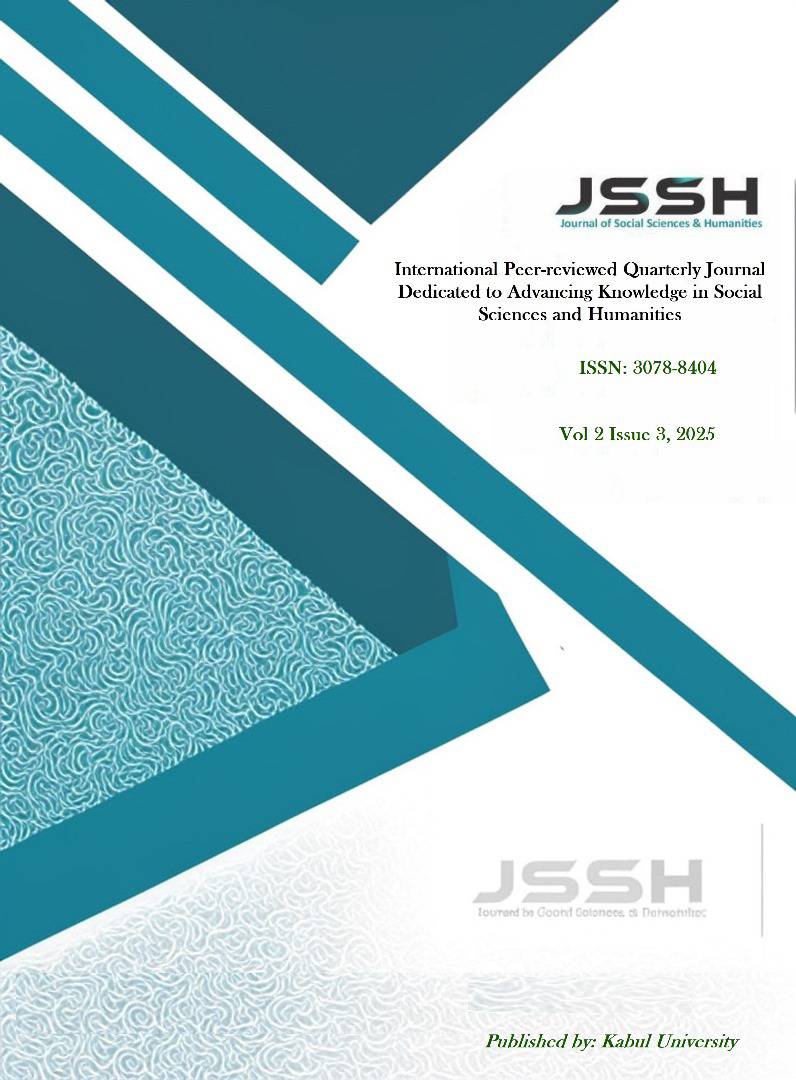New Issue Published – Journal of Social Sciences and Humanities, Vol. 2, Issue 3 (2025)

The Journal of Social Sciences and Humanities (JSSH) is pleased to announce the release of Volume 2, Issue 3 (2025). This issue features ten peer-reviewed articles that explore a broad spectrum of timely and interdisciplinary topics, including trauma and mental health, international relations, economic policy, educational equity, AI in service industries, translation studies, and the role of social media in cultural security.
Explore the full issue and engage with new research that is shaping contemporary discourse across the social sciences and humanities.
Explore the full issue to discover new research shaping contemporary discourse.
1. Traumatic Events, Post-Traumatic Stress Disorder, and Post-Traumatic Growth among University Students in Kabul City
Authors: Bezhan Ayubi, Khwaja Zabihullah Sediqi, Mohammad Jawad Mirzaee
DOI: https://10.62810/jssh.v2i3.114
This article explores the psychological impacts of traumatic events on university students, focusing on both post-traumatic stress and growth.
2. The Power of Ideas: A Constructivist Reinterpretation of Security in International Relations
Author: Nawid Aria
DOI: https://10.62810/jssh.v2i3.120
The study redefines security through a constructivist lens, emphasizing the influence of ideational factors in shaping international relations.
3. The Impact of Trade Openness on Economic Growth of South Asian Countries
Authors: Zubin Khaja Ahmadi, Yaqub Ali Rabin, Hamid Reza Qadamshahi
DOI: https://10.62810/jssh.v2i3.129
This article empirically analyzes how increased trade openness correlates with economic growth across South Asia.
4. AI in Service Industries: Effects on Customer Satisfaction, Mediated by Service Quality, and Moderated by Customer Trust
Authors: Azatullah Zaheer, Abdullah Sadiq, Noorulhaq Safi
DOI: https://10.62810/jssh.v2i3.82
The study investigates how artificial intelligence in service industries influences customer satisfaction, with trust and service quality as key factors.
5. Impact of Capital Structure on Firms' Performance: Evidence from Sample NESTS Emerging Countries
Authors: Ahsanullah Barakzai, Hatice Doğukanlı
DOI: https://10.62810/jssh.v2i3.125
This paper examines the relationship between capital structure and firm performance in selected emerging economies.
6. An Empirical Analysis of Trade Openness and Economic Growth in South Asian Countries
Authors: Naseerullah Safi, Nagendra Kumar Maurya
DOI: https://10.62810/jssh.v2i3.96
The article provides statistical evidence on the positive linkage between trade liberalization and economic development in South Asia.
7. From Chalkboards to Cultural Relevance: A Mixed-Methods Study on ELL Support in Post-Conflict Higher Education
Authors: Rasool Dad Islam, Esmail Qasemyar
DOI: https://10.62810/jssh.v2i3.93
This mixed-methods study explores challenges and culturally responsive strategies for supporting English language learners in post-conflict Afghan universities.
8. An Analysis of the Relationship Between Facebook Usage and Perceived Cultural and Social Security: A Case Study of Maimana City Residents
Authors: Rahimullah Zirak, Karimullah Noori, Salahuddin Qarizadah, Abdul Hasib Howaida
DOI: https://10.62810/jssh.v2i3.31
This article investigates the social and cultural impacts of Facebook usage among residents of Maimana city.
9. Foreignization and Domestication in Translating Culture-Specific Items: A Case Study of Yusuf Ali’s Surah Al-Baqarah
Authors: Sakhi Murad Ghorianfar, Muhammad Nabi Rahimi, Obaidullah Burhani
DOI: https://10.62810/jssh.v2i3.123
The paper analyzes translation strategies for handling culture-specific items in religious texts, using Yusuf Ali’s work as a case study.
10. The Role of Social Capital in Social Happiness: A Case Study of Youth Aged 18–40 in Kabul
Author: Gulabshah Amani
DOI: https://10.62810/jssh.v2i3.85
This research examines how different forms of social capital contribute to happiness among young people in Kabul.
We invite scholars, educators, and readers to explore this issue and engage with the published research. The full issue is available for open access on our official website.
Browse Archives | Submit a Manuscript
